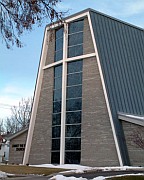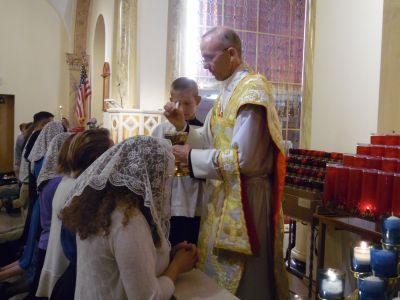We believe what you once believed.
We worship as you once worshipped.
If you were right then, we are right now.
If we are wrong now, you were wrong then.
From my friends at Fisheaters.com I present to you a 4 part series on Catholicism, discussing what you may see today in the church, how it came to be in the sorry state it is in, and what true Catholicism is all about. Enjoy!
Traditional Catholicism 101:
A Brief Primer
Part One
A typical scenario: You listen to E.W.T.N. or Catholic Answers and have found through them that the earliest Christians were Catholic, that Catholic dogma is not unscriptural. You become convinced that Jesus Christ did set up a Church, that He did so upon the rock of St. Peter, and that the gates of Hell will never prevail against it. You are willing to intellectually assent to the eternal teachings of the Church and truly desire to become a serious, committed Catholic who serves and worships Our Lord Jesus Christ.
You do what most people do in this case; you call up your local parish and get enrolled in an R.C.I.A. program. You don't hear much about Mary, the other Saints, sin, Purgatory, or Hell. You hear very little about the Mass as a propitiatory Sacrifice, but instead hear it described only as a "celebratory meal." Depending on the parish you find, you may hear and see things that seem totally contradictory to what you'd always heard the Catholic Church teaches. Your R.C.I.A. instructor may say things like, "The Catholic Church doesn't teach that any more since Vatican II" and may come off as religiously indifferent, not insistent enough that the Church is Christ's Church and that outside of Her there is no salvation.
The Masses offered seem not too unlike what you'd see at a Lutheran, "low church" Anglican, or maybe even a Pentecostal faith community. You've always associated "Catholic" with things like eating fish on Fridays, nuns in habits, confessionals, and stained glass -- with things that are ancient, mysterious, and beautiful. You look around your local parish and are wondering why nothing you see there seems to match up.
You were expecting this:

but got this:

You thought you'd see this: 
but see this instead: 
Sincere Catholics speak of the absolute sacredness of Communion,
so you thought that receiving would be more like this:

than like this:

Something in you is worried. What you are seeing and hearing in your local parish seems too -- Protestant. Or maybe even pagan or Unitarian. Whatever it is, it just doesn't add up. All sense of Mystery, of holiness, of ancientness, of beauty is missing. At the very least, it's just not "Catholic enough." It isn't reverent. It isn't holy. What is going on? How can you know if what you're being taught is truly Catholic if the "spirit" of your parish isn't Catholic? What has happened to the human element of the Church?
What Happened
Ever since the time of the so-called "Enlightenment" and up to the mid-twentieth century, Popes warned us with increasingly greater fervor against the enemies of the Church. From Pope Gregory XVI's Mirari Vos (1832), to Leo XIII's Humanum Genus (1884), to Pope Pius XI's Divini Redemptoris (1937), to Pope Pius XII's Humani Generis (1950), we have been warned that the Church has enemies, and that their errors are spreading. These errors -- whose roots go back to the Mystery of the "Synagogue of Satan" of the Apocalypse -- began to germinate during the so-called "Enlightenment" and are summed up by the word "Modernism."
Called the "synthesis of all heresies" by Pope St. Pius X, Modernism is summarized in the Catholic Encyclopedia thus:
A spirit of complete emancipation, tending to weaken ecclesiastical authority; the emancipation of science, which must traverse every field of investigation without fear of conflict with the Church; the emancipation of the State, which should never be hampered by religious authority; the emancipation of the private conscience whose inspirations must not be overridden by papal definitions or anathemas; the emancipation of the universal conscience, with which the Church should be ever in agreement; A spirit of movement and change, with an inclination to a sweeping form of evolution such as abhors anything fixed and stationary;
A spirit of reconciliation among all men through the feelings of the heart. Many and varied also are the modernist dreams of an understanding between the different Christian religions, nay, even between religion and a species of atheism, and all on a basis of agreement that must be superior to mere doctrinal differences.
The adherents of these ideas gained more and more power over time, fueled by Masonry and taking on guises as apparently disparate as usurious Capitalism and Communism. Most importantly, the Modernist enemies of Christ have even infiltrated into the human element of the Church itself. Pope St. Pius X warned about this in his 1907 encylical about Modernism, Pascendi Dominici Gregis:
"...the number of the enemies of the Cross of Christ has in these last days increased exceedingly, who are striving, by arts, entirely new and full of subtlety, to destroy the vital energy of the Church, and, if they can, to overthrow utterly Christ's kingdom itself. Wherefore We may no longer be silent, lest We should seem to fail in Our most sacred duty, and lest the kindness that, in the hope of wiser counsels, We have hitherto shown them, should be attributed to forgetfulness of Our office."
"That We make no delay in this matter is rendered necessary especially by the fact that the partisans of error are to be sought not only among the Church's open enemies; they lie hid, a thing to be deeply deplored and feared, in her very bosom and heart, and are the more mischievous, the less conspicuously they appear. We allude, Venerable Brethren, to many who belong to the Catholic laity, nay, and this is far more lamentable, to the ranks of the priesthood itself, who, feigning a love for the Church, lacking the firm protection of philosophy and theology, nay more, thoroughly imbued with the poisonous doctrines taught by the enemies of the Church, and lost to all sense of modesty, vaunt themselves as reformers of the Church; and, forming more boldly into line of attack, assail all that is most sacred in the work of Christ, not sparing even the person of the Divine Redeemer, whom, with sacrilegious daring, they reduce to a simple, mere man..."
"...We have said, they put their designs for her ruin into operation not from without but from within; hence, the danger is present almost in the very veins and heart of the Church, whose injury is the more certain, the more intimate is their knowledge of her. Moreover they lay the axe not to the branches and shoots, but to the very root, that is, to the faith and its deepest fires. And having struck at this root of immortality, they proceed to disseminate poison through the whole tree, so that there is no part of Catholic truth from which they hold their hand, none that they do not strive to corrupt."
There has been an influx into the Church of those who have, with or without malice, imbibed the spirit of "the Enlightenment," and there's been a full-scale, deliberate infiltration by outright malicious political enemies and religious heretics who share the goals and tactics of those who hold to "Enlightenment" ideals. Manning Johnson, a former official of the Communist Party in America, testified before the House Un-American Activities Committee in 1953:
"Once the tactic of infiltration of religious organizations was set by the Kremlin... the Communists discovered that the destruction of religion could proceed much faster through the infiltration of the Church by Communists operating within the Church itself. The Communist leadership in the United States realized that the infiltration tactic in this country would have to adapt itself to American conditions and the religious makeup peculiar to this country. In the earliest stages it was determined that with only small forces available to them, it would be necessary to concentrate Communist agents in the seminaries. The practical conclusion drawn by the Red leaders was that these institutions would make it possible for a small Communist minority to influence the ideology of future clergymen in the paths conducive to Communist purposes... The policy of infiltrating seminaries was successful beyond even our communist expectations."
A Catholic monk who heard ex-Communist Bella Dodd speak at Fordham University in the 1950s had this to say:
"I listened to that woman for four hours and she had my hair standing on end. Everything she said has been fulfilled to the letter. You would think she was the world's greatest prophet, but she was no prophet. She was merely exposing the step-by-step battle plan of Communist subversion of the Catholic Church. She explained that of all the world's religions, the Catholic Church was the only one feared by the Communists, for it was its only effective opponent.
The whole idea was to destroy, not the institution of the Church, but rather the Faith of the people, and even use the institution of the Church, if possible, to destroy the Faith through the promotion of a pseudo-religion: something that resembled Catholicism but was not the real thing.
Once the Faith was destroyed, she explained that there would be a guilt complex introduced into the Church…. to label the ‘Church of the past’ as being oppressive, authoritarian, full of prejudices, arrogant in claiming to be the sole possessor of truth, and responsible for the divisions of religious bodies throughout the centuries. This would be necessary in order to shame Church leaders into an ‘openness to the world,’ and to a more flexible attitude toward all religions and philosophies. The Communists would then exploit this openness in order to undermine the Church."
In the human element of our Church, we are seeing the results of this infiltration coupled with the effects of the pressures of secular materialism and sheer hedonism in the popular culture.

No comments:
Post a Comment